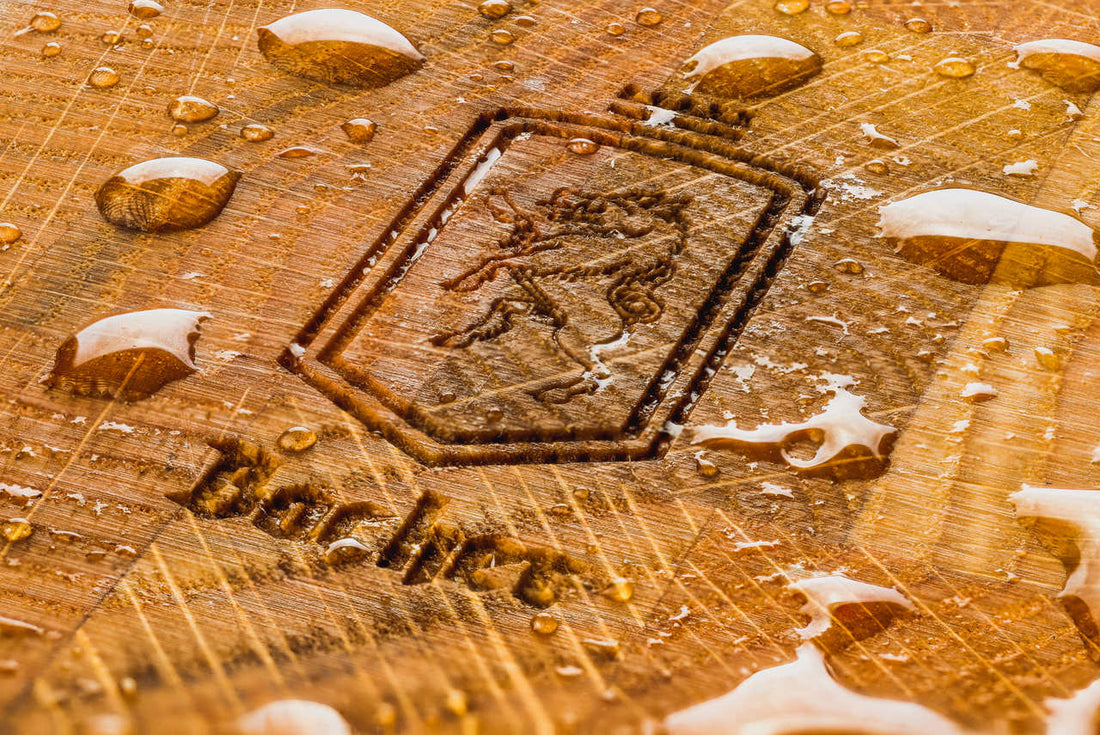Wooden surfaces, from furniture to kitchen chopping boards, delight with their variety of grains and natural warmth of colour. Each piece of wood has its own unique pattern and colour, which can be enhanced with proper care.
Without proper care, however, wood can lose its shine, dry out and even crack over time. This is why regular maintenance is so important. Fortunately, wood care does not have to be difficult or time-consuming – just a few simple treatments will ensure the natural beauty of your wooden surfaces remains pleasing to the eye for many years.
Enhances the texture and colour of wood
Natural wood is beautiful in itself, but we can make it look even better. The key is to protect and finish the surface in a way that highlights the grain and intensifies the colour, rather than concealing them. Natural oils and waxes are most often used for this purpose. Oiling wood slightly darkens the material, giving it a warm honey colour, while simultaneously highlighting the unique grain patterns. Wood oil gives the surface depth – the colour becomes more saturated and the grain becomes more visible and contrasting. Importantly, oiled wood still looks natural: the oil penetrates its structure without creating an artificial, thick coating.
Waxing (or using a special wood conditioner containing beeswax or carnauba wax) creates a thin, protective layer on the surface of the wood. The wax makes the wood silky and smooth to the touch, while protecting it from dust and moisture. Furthermore, it effectively fills the pores and small irregularities, making the wood's texture more pronounced to the touch and in the way it reflects light. Once the preparation has been applied, the wood can shine beautifully, exposing the grain pattern with every touch of light. Oil and Carnauba wax conditioner can also be used together — first apply the oil for impregnation, then polish with the wax for a shine. These two natural finishing methods emphasise the most valuable aspect of wood: its natural appearance. Unlike thick varnishes, they do not create a 'plastic' barrier, but retain the authentic character of the wood.
Step-by-step regular care:
Regularly oiling wooden accessories (e.g. bowls and chopping boards) protects them and highlights the grain. Wood is a natural material that requires regular maintenance to preserve its properties over time. Over time, water, temperature changes and everyday use can cause deformation, cracking and a loss of colour and smoothness of the surface. Regular maintenance prevents these problems by protecting the wood from absorbing moisture (which prevents cracking) and stains, helping wooden objects to retain their aesthetic appearance for longer. Furthermore, well-maintained wood feels more pleasant to the touch and is easier to keep clean. Below is a simple, step-by-step care plan that will help you enjoy the beauty of wooden surfaces every day.
1. Clean and prepare the surface. Before applying anything, ensure the wood is clean and completely dry. Remove any dust and dirt with a soft cloth. If the item was washed with water (e.g. a wooden chopping board), make sure it is completely dry before proceeding, as moisture in the wood will prevent the oil from being absorbed properly. If the surface is rough or has old layers of finish, you can gently sand it down with fine-grained sandpaper, always working with the grain. This will make the wood smoother and enable the oil to penetrate the wood more effectively. After sanding, vacuum the surface again to remove dust.
2. Oiling the wood. Apply a small amount of wood oil to a clean, soft cloth or brush, then spread it evenly over the surface. Rub the oil in using circular motions or along the grain to allow it to penetrate the wood's pores. It is better to add more oil if the wood absorbs it quickly than to flood the surface with excess oil. Once you have covered the entire area, leave the oil to soak in. Depending on the type of oil and wood, this could take a few hours or even overnight. Then come back and wipe off the excess oil with a clean cloth, buffing the surface lightly. This will ensure the wood absorbs as much oil as it needs, rather than leaving a sticky residue on top.
3. Wax (optional). If you want to provide extra protection and shine, you can apply wax after the oil has dried. Use a soft cloth or cotton pad to apply a thin layer of wood conditioner containing wax to the entire surface. Then polish the wood in circular motions, pressing lightly - the heat of friction will help the wax penetrate the pores and create a smooth coating. Leave the wax to dry for several minutes, then polish the surface with a clean cloth to a shine. Wax with the addition of e.g. beeswax will create a protective, breathable layer and give the wood a beautiful shine, bringing out the depth of color. This step will make the wood even better protected against moisture and dirt, while at the same time velvety to the touch .
4. Repeat the treatment regularly. Natural oils and waxes wear out over time – the oil gradually evaporates and the wax layer wears off with use. Therefore, to maintain optimal protection and appearance, it is worth repeating the treatment periodically. How often you do this depends on the type of item and how often it is used. For example, kitchen boards and worktops, which are often in contact with water and food, should be oiled about once a month. Furniture that is not used so much can be refreshed with oil or wax once every few months, or whenever the wood starts to look dry and dull. Consistency is key – frequent, light treatments are more effective than infrequent, thorough renovations. Thanks to this, the wood always remains in great condition, and we prevent damage that is difficult to reverse.

Oils and conditioners for wood - why is it worth it?
Wood care products, such as oils and waxes, have long been popular among professionals and DIY enthusiasts looking after their home furnishings. Wood oil penetrates deep into the wood's structure, protecting it from moisture and drying out from the inside. At the same time, it leaves a natural matte or satin finish that enhances the colour without forming a thick layer on top. Wax conditioners, on the other hand, work more superficially, creating a thin protective film that gives wood an elegant shine and smooth texture. Waxes, such as beeswax or vegetable carnauba, fill the micro-pores of the wood to protect it from dirt and water while emphasising the grain pattern on the surface. Oils and waxes can be used separately or together to complement each other's effects. Why is it worth using them? Below are some of the most important advantages of natural wood care:
-
Highlighting beauty and the natural appearance: Oiling and waxing can make wood look new again, restoring its fresh colour, subtle shine and distinctive grain texture. Natural finishes expose the grain, meaning each piece of furniture or object retains its unique character. The wood looks warm and cosy, and we can still see and feel its true structure, which adds to its charm.
-
Protection against moisture and damage: Impregnating wood with oil or wax creates a protective barrier that prevents water from penetrating the material. This makes the wood less susceptible to cracking, warping or mould growth when humidity changes. Additionally, the protected surface is stain-resistant — oil/wax closes the wood's pores against dirt and discolouration, which raw, unprotected wood is susceptible to. A wax coating can also protect against minor scratches, creating a slippery, easily renewable finish.
-
Safe for health and the environment: Most natural oils and waxes do not contain aggressive chemicals or toxins. Oils based on natural ingredients, such as coconut oil, linseed oil and food-grade mineral oil, are neutral in terms of health and are often safe to come into contact with food, which is important when preserving items such as wooden chopping boards or children's toys. Beeswax and carnauba wax are also natural products. The absence of synthetic additives means these products do not emit harmful fumes and can be used at home without worry. Furthermore, they allow wood to 'breathe' by not completely closing its surface, enabling moisture to evaporate gradually and allowing the wood to retain its natural properties.
-
They are easy to apply and renovate: Using natural products is simple and does not require specialist equipment. All you need is a cloth, some oil or wax, and a few minutes. This means we can maintain our furniture and other items ourselves, without taking them to a professional workshop. Importantly, oiled or waxed surfaces can be easily spot-renovated — minor scratches or chips can be lightly sanded and then re-oiled or waxed, making them disappear without a trace. Unlike varnish, there is no need to strip the entire coating – regular, localised care keeps the wood in great shape. This saves time and money, and is convenient because we can maintain a high gloss and protection with little effort.
-
Extending the life of wood: Natural care is an investment that pays off. Oils and waxes improve the appearance of wooden surfaces and significantly extend their durability. Wood that is protected from water, drying out and damage ages more slowly – it cracks less, does not dry out and does not lose its colour as quickly. This means that your favourite wooden table or countertop will retain its charm for many years of intensive use. Regular impregnation also makes wood more resistant to everyday wear and tear, ensuring that any changes occur evenly and aesthetically, creating a natural patina rather than unsightly stains or crumbling. As a result, there is less need for replacement or expensive renovation of the furniture – just take care of it on an ongoing basis.
In summary, with a little effort, we can ensure that the wooden elements in our surroundings retain their charm for a long time. Regular maintenance using oils and conditioners not only extends the durability of wood, but also enhances its natural beauty. It is worth stocking up on high-quality, natural wood care products and incorporating them into your regular cleaning routine. In this way, our furniture, floors, and wooden accessories will reward us with a wonderful appearance and durability, as well as the unique charm that only real wood can offer. After all, the natural beauty of wood truly flourishes when it is cared for!

